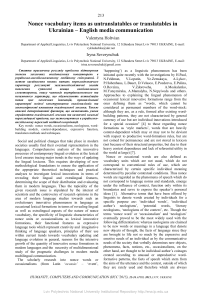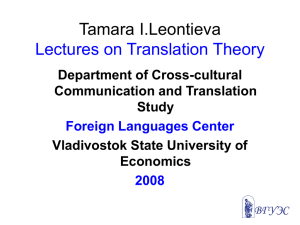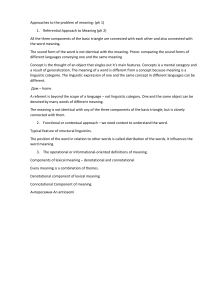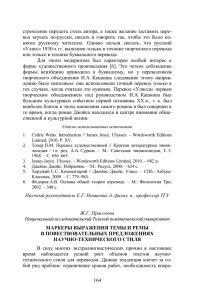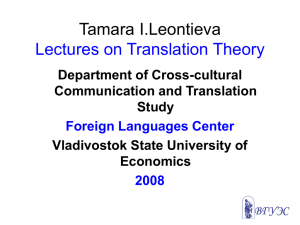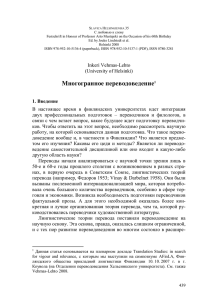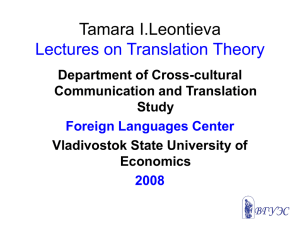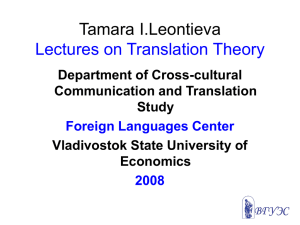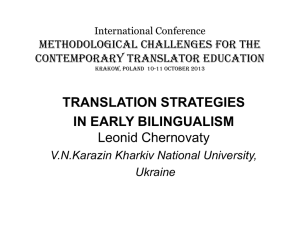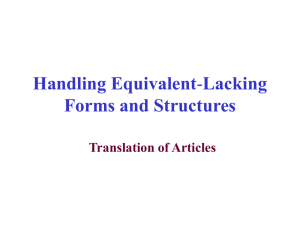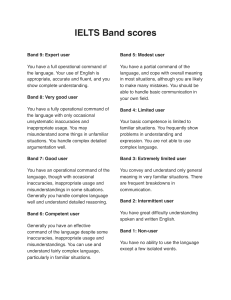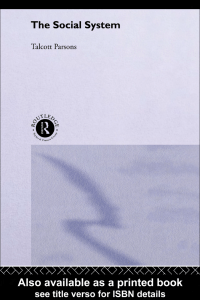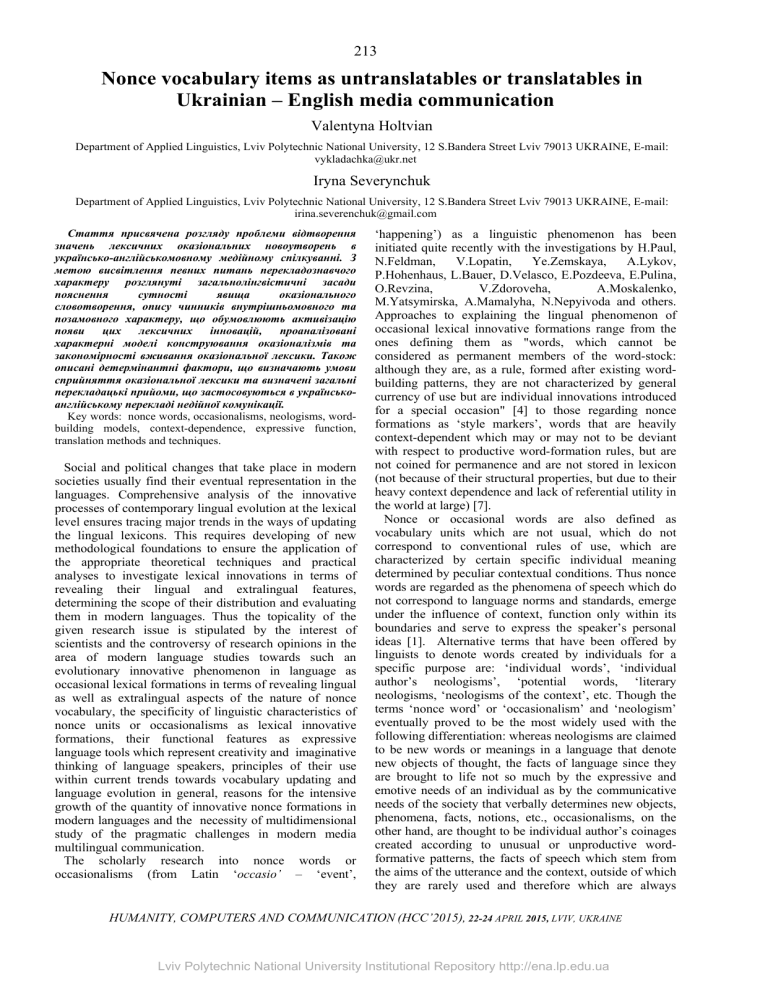
213 Nonce vocabulary items as untranslatables or translatables in Ukrainian – English media communication Valentyna Holtvian Department of Applied Linguistics, Lviv Polytechnic National University, 12 S.Bandera Street Lviv 79013 UKRAINE, E-mail: vykladachka@ukr.net Iryna Severynchuk Department of Applied Linguistics, Lviv Polytechnic National University, 12 S.Bandera Street Lviv 79013 UKRAINE, E-mail: irina.severenchuk@gmail.com Стаття присвячена розгляду проблеми відтворення значень лексичних оказіональних новоутворень в українсько-англійськомовному медійному спілкуванні. З метою висвітлення певних питань перекладознавчого характеру розглянуті загальнолінгвістичні засади пояснення сутності явища оказіонального словотворення, опису чинників внутрішньомовного та позамовного характеру, що обумовлюють активізацію появи цих лексичних інновацій, проаналізовані характерні моделі конструювання оказіоналізмів та закономірності вживання оказіональної лексики. Також описані детермінантні фактори, що визначають умови сприйняття оказіональної лексики та визначені загальні перекладацькі прийоми, що застосовуються в українськоанглійському перекладі недійної комунікації. Key words: nonce words, occasionalisms, neologisms, wordbuilding models, context-dependence, expressive function, translation methods and techniques. Social and political changes that take place in modern societies usually find their eventual representation in the languages. Comprehensive analysis of the innovative processes of contemporary lingual evolution at the lexical level ensures tracing major trends in the ways of updating the lingual lexicons. This requires developing of new methodological foundations to ensure the application of the appropriate theoretical techniques and practical analyses to investigate lexical innovations in terms of revealing their lingual and extralingual features, determining the scope of their distribution and evaluating them in modern languages. Thus the topicality of the given research issue is stipulated by the interest of scientists and the controversy of research opinions in the area of modern language studies towards such an evolutionary innovative phenomenon in language as occasional lexical formations in terms of revealing lingual as well as extralingual aspects of the nature of nonce vocabulary, the specificity of linguistic characteristics of nonce units or occasionalisms as lexical innovative formations, their functional features as expressive language tools which represent creativity and imaginative thinking of language speakers, principles of their use within current trends towards vocabulary updating and language evolution in general, reasons for the intensive growth of the quantity of innovative nonce formations in modern languages and the necessity of multidimensional study of the pragmatic challenges in modern media multilingual communication. The scholarly research into nonce words or occasionalisms (from Latin ‘occasio’ – ‘event’, ‘happening’) as a linguistic phenomenon has been initiated quite recently with the investigations by H.Paul, N.Feldman, V.Lopatin, Ye.Zemskaya, A.Lykov, P.Hohenhaus, L.Bauer, D.Velasco, E.Pozdeeva, E.Pulina, O.Revzina, V.Zdoroveha, A.Moskalenko, M.Yatsymirska, A.Mamalyha, N.Nepyivoda and others. Approaches to explaining the lingual phenomenon of occasional lexical innovative formations range from the ones defining them as "words, which cannot be considered as permanent members of the word-stock: although they are, as a rule, formed after existing wordbuilding patterns, they are not characterized by general currency of use but are individual innovations introduced for a special occasion" [4] to those regarding nonce formations as ‘style markers’, words that are heavily context-dependent which may or may not to be deviant with respect to productive word-formation rules, but are not coined for permanence and are not stored in lexicon (not because of their structural properties, but due to their heavy context dependence and lack of referential utility in the world at large) [7]. Nonce or occasional words are also defined as vocabulary units which are not usual, which do not correspond to conventional rules of use, which are characterized by certain specific individual meaning determined by peculiar contextual conditions. Thus nonce words are regarded as the phenomena of speech which do not correspond to language norms and standards, emerge under the influence of context, function only within its boundaries and serve to express the speaker’s personal ideas [1]. Alternative terms that have been offered by linguists to denote words created by individuals for a specific purpose are: ‘individual words’, ‘individual author’s neologisms’, ‘potential words, ‘literary neologisms, ‘neologisms of the context’, etc. Though the terms ‘nonce word’ or ‘occasionalism’ and ‘neologism’ eventually proved to be the most widely used with the following differentiation: whereas neologisms are claimed to be new words or meanings in a language that denote new objects of thought, the facts of language since they are brought to life not so much by the expressive and emotive needs of an individual as by the communicative needs of the society that verbally determines new objects, phenomena, facts, notions, etc., occasionalisms, on the other hand, are thought to be individual author’s coinages created according to unusual or unproductive wordformative patterns, the facts of speech which stem from the aims of the utterance and the context, outside of which they are rarely used and therefore which are always HUMANITY, COMPUTERS AND COMMUNICATION (HCC’2015), 22-24 APRIL 2015, LVIV, UKRAINE Lviv Polytechnic National University Institutional Repository http://ena.lp.edu.ua 214 expressive [6]. Another point of distinction between these two types of language units is their function. The primary function of neologisms is the nominative one, i.e. denoting new objects, phenomena, etc. The main function of occasional units, on the other hand, is the expressive one. These units are created and used in order to characterise the fictional reality or its parts in an expressive and artistic way that would attract the readers’ attention. Therefore, regarding the peculiar features of occasionalisms it is possible to distinguish the following ones: — occasionalisms are created for a single occasion in order to serve a specific situation; — the novelty and unusualness of perception is a typical and permanent feature of occasionalisms as opposed to neologisms which lose their novelty with the lapse of time; — it is impossible to predict the appearance of occasionalisms in a series of speech elements; nominative optionality is yet another feature inherent in them; — occasionalisms are characterized by very high degree of expressiveness due to the novelty and freshness of perception as well as intense concentration of meaning [2]. A.Rebriy in the attempt to analyse the factors that determine emergence of occasional lexical elements in language distinguishes between two crucial ones: extralingual and intralingual. The extralingual factors that may induce the speakers to search for new elements are: 1) objective nominative deficiency — when a new object, phenomenon has appeared and does not have any denotation in the language or when a notion exists however it designated descriptively by a wordcombination; 2) subjective nominative deficiency — when a particular meaning, form or construction is absent in the individual set of language means used by a certain speaker; it is caused by scarcity of individual’s ‘inner vocabulary’ and is always confirmed by the context; 3) expressive and emotional deficiency — when the speaker considers the existing language means expressively and emotionally insufficient for the characteristics of a certain situation or when the author wants to add a certain stylistic shade to a word or phrase. The intralingual factors, which include the mechanisms of a language system that when combined together ensure the generic function of a language, according to A.Rebriy are: 1) the law of language economy according to which a person uses only the amount of efforts that is sufficient enough for being understood; 2) language analogy – new units are coined on the basis of already existing words, word combinations, syntactic construction [3]. Analysis of the research works and approaches to the typology of nonce words or occasionalisms has led to the conclusion about the following main typological categories of such units: 1) phonetic occasional words (absolutely new words in the form of any sound combination created by an author with the idea that this combination bears a certain semantics that depends on phonetic meanings of sounds the word consists of); 2) lexical occasional words (words often created by means of combination of various usual conventional stems and affixation according to the rules of word-building or even contradicting them; 3) grammatical (morphological) occasional words (words the grammatical form and semantics of which contradict each other from the usual point of view); 4) semantic occasional words (words which are the result of appearance of new meanings that considerably transform the semantics of an initial usual lexeme that was used in a text); 5) occasional (unusual) combinations of words (confluence of lexemes compatibility of which is impossible in customary usage since it contradicts the law of semantic agreement in consequence of the absence of common sense in their lexical meanings) [9]. It appears as a well-established idea that such innovative lexical units as nonce words appear in a language in the following ways: — by means of word composition; — by means of word building derivation; - by means of semantic derivation; — by means of borrowing from other languages or subsystems of the language [3]. Changes that occur today in the social-political and economic life most clearly and quickly manifest themselves in the language of mass media. The language of media communication becomes a benchmark of rulemaking factor that affects the common modern trends. New words, figurative words and phrases, slang and nonce words are coined in the language of media so swiftly that no dictionary can and should register them immediately. Indeed, the number of new words appearing in mass media during a year amounts to tens of thousands in languages. In terms of multilingual media communication it goes without saying that nonce words or occasionalisms pose perhaps the greatest challenge for a professional translator. The problem of translation of such words ranks high on the list of challenges that translators face because new lexical formations as nonce words with the view to their specific feature that is being a part of a particular case or speech situation such kinds of words do not tend to find their permanent position in a language and retain their originality are known not to have their counterparts in the target language, being results of creation of new meaning and new form they are not readily found in dictionaries and even in the newest specialized dictionaries [6]. E.Shapochkin and L.Butenko claim that "difficulties of occasionalisms translation are the result of the fact that occasionalisms comprise up to several meanings or may not have corresponding constructions in target-language. It is advised to translate occasionalisms by means of language constructions existing in target-language or to invent one’s own new occasionalism and describe it in the footnotes. This process is highly creative..." [8]. Some researchers mention the idea of certain ‘mental formations’ that appear in an author’s mind in the process of creating a text and occasional units. The success of translation of occasional words thus depends on that fact whether the so-called ‘mental formations’ of an author and a translator agree with each other or not and if a translator can choose the appropriate method of translating [9]. The others suggest that translators should try to preserve the form and meaning of an occasional HUMANITY, COMPUTERS AND COMMUNICATION (HCC’2015), 22-24 APRIL 2015, LVIV, UKRAINE Lviv Polytechnic National University Institutional Repository http://ena.lp.edu.ua 215 word in the process of interpretation resorting to the usage of the models of word-building wherein the analysis of words and morphemes may appear an additional helpful tool in finding out the meaning of a nonce word [2]. Yet there are claims that applying methods of interlingual translation (creating an occasional word in a target language, translation with a usual word, transcription/transliteration, and omission) allows achieving different degrees of translation of an initial unit. Within this approach the first method helps to preserve structural features of initial occasional units and the last one leads to the loss of an occasional word and it is necessary to compensate it with the help of stylistic devices. Selecting the appropriate method of translation depends not only on a translator but also on the method of creating of an occasional word in a source text [9]. Within the area of translation studies nonce words are ofen referred to as untranslatables, which means translators find it virtually a very difficult task to decipher the meanings of such emotional and expressive units of free and spontaneous play of words which have acquired almost inconceivable appearance. Though as recent studies suggest, rendering occasional lexical formations and solving the problem of their translatability depends rather on the ability of a translator to use efficiently the resources of various types of knowledge (lingual as well as extralingual). Therefore, interpreting the meanings of occasional innovative lexical formations is predetermined by the context in which the lexical unit is used as well as it is preconditioned by their form. According to A.Horchkhanova, context is crucial since it ensures perception and understanding of nonce words, which in isolation may be ambiguously interpreted, context may alter the way such units are interpreted, it determines their efficiency in performing the nominative function as well as reveals their peculiar functional features, it also serves to specify the interpretation of wor-building patterns [2]. As it was previously mentioned, ways of occasional words’ translation are also preconditioned by their form. Trying to explain new meanings translators make analysis of word-building models which make up the basis for nonce words, decode patterns their constituent elements are combined and using the grammatical characteristics of the elements decode the meaning of the whole word proceeding from its grammatical structure. Accurate interpretation of meanings of nonce words requires detailed analysis of the type of context a nonce word is used in, the typological category a nonce word belongs to and the type of wordbuiding pattern the form of a nonce word follows. In the area of modern translation studies scientists distinguish the following translation methods and techniques that are widely applied in the process of rendering the meanings of nonce words: transliteration, transcription, descriptive translation, calquing, applying lexical-semantic transformations. To prove or disprove the thesis about the possibility of implementation of above-mentioned translation mechanisms in the process of rendering the occasional lexical formations the analysis of the Internet recent editorial publications of the Kyiv Weekly and The Day Newspapers in Ukrainian as the source language and their translated versions in English as the target language has been conducted. Firstly, the materials under analysis have been processed in terms of determining the word-building patterns that the occasional vocabulary elements in the articles followed. The conclusion is that the majority of investigated elements are formed by means of word building derivation (70 %), or more precisely by affixation (e.g.: піксиляції, доларизація, олігархізація, відтермінування, тінізація, комуністичність, упрощенка, боротьбисти, шумськізм, etc.) as well as by means of word composition (25%) (e.g.: кросдефолт, епоха-після-обов’язку, маски-шоу, націоналуклоністи, etc.) and only 5% by means of abbreviation. Secondly, the analysis of application of particular methods and techniques in translating the selected nonce elements from Ukrainian into English has been carried out. The results demonstrate that majority of investigated occasional elements are translated from Ukrainian into English by means of: — calquing (35%) (e.g.: антитимошенківський запал-‘anti-Tymoshenko temper’, тінізація-‘shadowization’, мультиплекси‘multiplexes’, сек'юритизація-‘securitization’, доларизація-‘dollarization’, форум-фієста-‘fiesta forum’, епоха-після-обов’язку-post-duty epoch, піксиляції-‘pixilations’); and by means of — descriptive translation (35%) (e.g.: бютівці-'prolific members of BYT', відтермінування-‘the job completion to a later date in the future’, рознарядка-‘special figures’, маскишоу-‘masked teams of special forces’, зони із великою клатерністю-‘advertisement-packed areas’, націоналуклоністи-‘the so-called “national deviationists’); and quite rarely there are applied: — transcription (5%) (e.g.: шумськізм-‘Shumskism); — transliteration (10%) (e.g.: упрощенка-‘uproshchenka); — transliteration of the word with explication of its meaning (e.g.: незалежникиnezalezhnyky-‘independents’); — transformation of generalization (5%) (e.g.: суньятсенівки-‘dresses of the Tang Dynasty and a Zhongshan costume’); and — simplification of meaning (5%) (e.g.: відтінок деякої «комуністичності» чи «соціалістичності»-communist or socialist shade). Therefore, the problem of nonce words phenomenon appears to be quite a disputable one in modern language studies. Different approaches view controversially the status of such innovative lexical formations as to whether they should be regarded as just peculiar occasional speech elements or neological language units. The distinguishing characteristic features of nonce words are thought to be a sign of novelty and context-dependence. Nonce or occasional units of speech are a kind of divergence from the conventional language norms, they differ from usual ones due to their monosemantic structure and at the same time the expressivity of their meaning. They are created in an absolutely individual manner that appears as a result of intentional violation of language standards and is determined by the specific context of usage. Nonce words are complex multi-aspect phenomenon in the perception HUMANITY, COMPUTERS AND COMMUNICATION (HCC’2015), 22-24 APRIL 2015, LVIV, UKRAINE Lviv Polytechnic National University Institutional Repository http://ena.lp.edu.ua 216 of which their typological characteristics, their wordfomative models, contextual features and the recipients’ lingual as well as extralingual competence appear to be crucial. Rendering nonce words from one language into the other requires making individual, independent and highly creative translator’s decision. Challenges in translating nonce or occasional words in general and in rendering the meanings of such units in UkrainianEnglish media communication in particular are determined by special difficulties in perceiving them. This, as the studies suggest, depends on the accuracy and fluency of a translator in decoding nonce element wordbuilding patterns, revealing contextual influences while applying lingual and extralingual knowledge in implementing the appropriate translation methods and techniques. References 1. Ахманова О.С. Словарь лингвистических терминов / О.С. Ахманова. - 2-е изд., стер. - М : УРСС : Едиториал УРСС, 2004. - 571 с. 2.Горчханова А. Особенности перевода окказионализмов. – Режим доступа: http://www.academia.edu/5159275/. 3.Ребрий А.В. Окказионализмы в современном английском языке (структурно-функциональный анализ): дис... канд. филол. наук: 10.02.04 / Ребрий Александр Владимирович ; Харьковский гос. ун-т. Х., 1997. - 203 с. — Режим доступа: http://www.irbisnbuv.gov.ua/cgiuv/cgiirbis_64.exe?Z21ID=&I21DBN=E C&P21DBN=EC&S21STN=1&S21REF=10&S21FMTf. 4.Ревзина О. Г. Поэтика окказионального слова // Язык как творчество: Сборник научных трудов к 70летию В. П. Григорьева. — М., 1996. — С. 303-308. — Режим доступа: <http://www.philology.ru/linguistics2/revzina-96.htm>. 5.Стишов О. А. Українська лексика кінця XX століття (на матеріалі мови засобів масової інформації) / Стишов О. А. – 2-ге вид., переробл. –: Пугач К., 2005. – С. 289–331. 6.Шаповалова Г. Лексичні й семантичні неологізми в мові сучасної української преси // Сучасні проблеми мовознавства та літературознавства: Зб. наук. праць (Ужгород. держ. ун-т Міносвіти України). – Ужгород, 2000. – Вип. 3. – С. 234-239. 7.Munat J. Lexical creativity, texts and contexts. — Amsterdam: John Benjamins Publishing Company, 2007. — 185p. — Available from: <http://www.academia.edu/10501572/Recension_de_Mu nat_J._ed._Lexical_Creativity_Texts_and_Contexts_Stud ies_in_Functional_and_Structural_Linguistics_SFSL_>. 8.Shapochkin Е.А., Butenko L.N. Detection of requirements for models of knowledge representation for the domain of occasionalisms translation / Е.А. Шапочкин, Л.Н. Бутенко // Успехи современного естествознания. – 2011. – № 4. – C. 163-164. – Англ. – Available from: < http://econf.rae.ru/article/5739 >. 9.Smirnova E., Sadykova A., Davletbaeva D. The study of occasional words: theoretical aspect. //Life Science Journal. – 2014. – Vol.11. – P.532-535. – Available from: <http://www.lifesciencesite.com. 92>. HUMANITY, COMPUTERS AND COMMUNICATION (HCC’2015), 22-24 APRIL 2015, LVIV, UKRAINE Lviv Polytechnic National University Institutional Repository http://ena.lp.edu.ua
